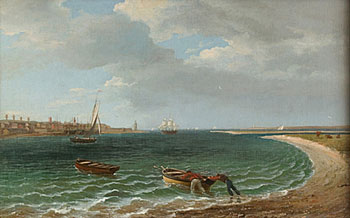
Nantucket Historical Association Thomas Birch
Nantucket is an island 30 miles (48.3 km) south of Cape Cod, Massachusetts. Together with the small islands of Tuckernuck and Muskeget, it makes up the town of Nantucket. Today it is a tourist destination and summer colony, but during the 18th and early 19th century, it was the world's leading whaling port.
The island was formed by the Laurentide Ice Sheet and shaped by the rise in sea level as the glacier melted. It became an island, separate from the mainland about 5,000 - 6,000 years ago. Nantucket island proper is 47.8 sq. mi. (123.8 km), less than 15 miles across and 3 miles wide and is bounded by Nantucket Sound and the Atlantic Ocean. It has a large, protected harbor.
Nantucket's weather is mild because it is close to the Gulf Stream's warm water. Along with the warm air, fog often rolls in and, Nantucket's nickname is the "Grey Lady."
Originally inhabited by the Wampanoag Indians, English settlers arrived in 1659. Shortly after 1700, Quakerism began to take root on Nantucket, and by the end of the 18th century, the largest denomination on the island was the Society of Friends. Quakers became extremely influential in business and government matters.
Nantucket reigned as the whaling capital of the world from the mid-1700s to the late 1830s. During its peak, as many as 15l whaling vessels sailed from Nantucket. The people who remained on the island also prospered with many men working at the sail lofts, warehouses, coopers'shops blacksmith shops, and candle factories.
Its shallow harbor entrance made it difficult for heavily loaded whaleships to enter and eventually, more and more ships sailed out of New Bedford. The development of the railroad on the mainland also made it easier to transport whale oil.
JavaScript required access all features of this site. Use Browser Back to return.